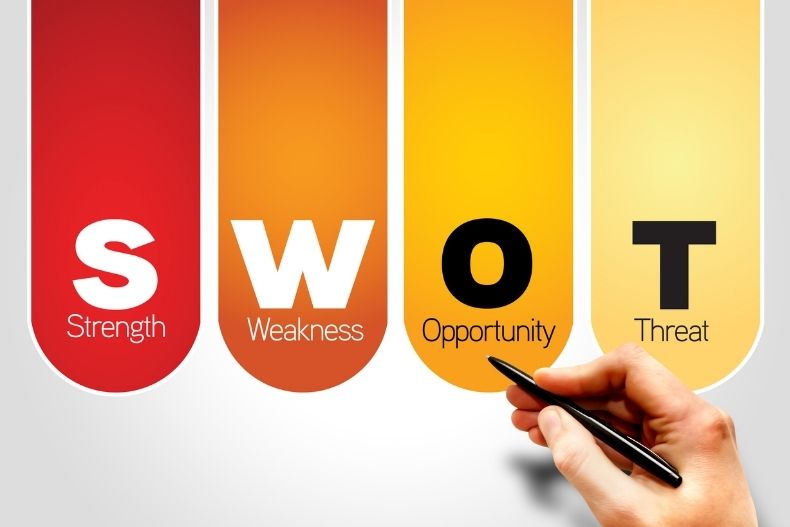You have started your business, hired employees, worked on your product or service, and even gotten clients. Congratulations!
At this point, you may realize the need to continuously assess your business to identify what you need to keep up, reduce, or change entirely.
Albert Humphrey, a management consultant, proposed the SWOT analysis tool in the 1960s. Decades later, this analytic tool has withstood the sands of time and has proven its prowess in aiding businesses’ long-term planning.
What is SWOT Analysis

SWOT is an acronym for strengths, weaknesses, opportunities, and weaknesses. Therefore, a SWOT analysis refers to making a self-assessment of your business in terms of the aforementioned four parameters.
Strengths and weaknesses are internal factors within your control, whereas opportunities and threats are external factors beyond your control.
We shall assess your business in terms of your products or service, process, customers, distribution, finance, and administration.
How to Conduct a SWOT Analysis
Here, we will look at the four parameters individually. Incorporated are the questions to ask yourself as you evaluate your business.
Strengths
Strengths are the factors that give your business an upper hand over its competitors.
-
- Service: Is your service valuable? A valuable service is prestigious and often expensive. Is your service rare? Only a few highly skilled individuals can perform a rare service. Is your product imitable? An imitable service can easily be imitated; hence it does not have a competitive advantage.
- Process: Do you have an effective operational plan in place? An effective operational plan entails the tasks to be performed, details of who is to complete each task, the deadline for performing each task, and how much resources have been dedicated to performing a particular task.
- Customers: Has your business created a seamless customer experience? The customer experience delves into customers’ processes and emotions as they research, decide, purchase, and access after-sale services offered by your business. Have you built a loyal customer base? Are your customers satisfied with your product and services?
Weaknesses
This step allows you to reflect on the shortcomings of your business.
-
- Service: What complaints have you received about your service?
- Process: Is your service process cost-effective and meets deadlines? What issues have been raised by employees?
- Customers: Can customers easily find details of how to use your product? What factors may hinder customer satisfaction with your service?
- Distribution: Are there areas with the target market that do not receive the service or product? How efficient is the transport process?
- Finance: Are you losing any money scrupulously or through avoidable expenses?
- Administration: Is the administrative structure covering all the bases? Do the leaders work for the benefit of employees and customers?
Opportunities
Here, you identify potential sources of income or growth. Identifying opportunities get you out of the ‘red ocean’ with lots of competition and into the ‘blue ocean’ without competition and many untapped potentials and unexplored market niches.
-
- Service: How can you revolutionize your service into the best of its kind?
- Process: Which resources can you use that have not been used before or are underutilized?
- Customers: Which potential markets can you venture into?
- Distribution: Are there cheaper, more efficient, and environmentally friendly means of distribution you can adopt?
- Finance: How can you create new sources of income or save up on what you already make?
- Administration: How can you increase the efficiency of the administrative body?
Threats
This step requires you to study your niche and identify potential threats.
-
- Service: What potential threats could afflict your service? Is it the entry of more freelancers with cheaper rates or even innovations that could negate the need for your product or service?
- Process: What impending threats could affect the production or operation process? Can technological advancements create systems that can autonomously provide freelancing services?
- Customers: What threats can change customer preferences, loyalty, or satisfaction with your service?
- Distribution: Is your method of distribution unsustainable or unable to meet increased demand?
- Finance: What factors are causing you to spend too much money or incur losses? Could governments impose more taxes on freelancers?
- Administration: Is the administrative structure amicable to employees? Is there conflict among the freelancers or board members?
You have now finished compiling information. Summarize your findings into four boxes.
The information you have gotten shows you what to introduce, uphold, reduce, and eliminate. Factor these findings into a strategy map. If you don’t know what a strategy map is, in simple terms, it is a diagram that shows your organization’s strategy on a single page. This map will now be your business’s compass.
Remember that every successful business requires all hands on deck. Keep your employed freelancers involved by seeking their views while conducting the SWOT analysis and building the strategy map.
Conduct a SWOT analysis either once or twice annually.
What Are the Benefits of Conducting a SWOT Analysis?
-
- By identifying your strengths, you get to know what to build on and maintain.
- It enables you to catch your weaknesses; hence rectify them early. Better to repair a hole before the entire boat sinks.
- Analysis of opportunities enables you to identify potential areas of growth.
- By analyzing your threats before they occur, you get to steer your business away from them.
- SWOT analysis gauges the performance of your business.











